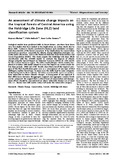An assessment of climate change impacts on the tropical forests of Central America using the Holdridge Life Zone (HLZ) land classification system
Résumé
Ecological models have predicted shifts in forest biomes, yet there have been
very few studies that have looked at the implications on carbon stocks due to
these shifts. Carbon is closely correlated to biomass and constitutes an important
characteristic of the forest ecosystem. It has implications for conservation
and land use practices, especially for climate change mitigation strategies currently
under discussion, such as the Reduced Emissions from Deforestation and
Forest Degradation (REDD). This study couples the Holdridge Life Zone (HLZ)
classification with the ECHAM5 model, to evaluate the impacts of climate
change using the Special Report on Emissions Scenarios (SRES) A2, A1B and B1
for the Central American region. We utilize methodologies which combine biophysical
variables with model output to assess the impacts on carbon stocks for
two time periods, 2000 and 2100. Results show that overall the tropical category
of the HLZ classification gains area as a consequence of one type of HLZ
shifting to another forest type. In many cases the shifts lead to some categories
of HLZ being lost in their entirety. Elevation-associated life zones are particularly
vulnerable to future climatic changes. A strong point of our approach is
that differences between disaggregate regional and aggregate country levels
can be compared. We suggest that a critical focus of conservation and management
efforts should be concentrated on where vulnerable biomes are at most
risk, i.e., biomes that shift and/or reduce fall under the vulnerable category.
Keywords
Collections
- Publicaciones y documentos [3648]


